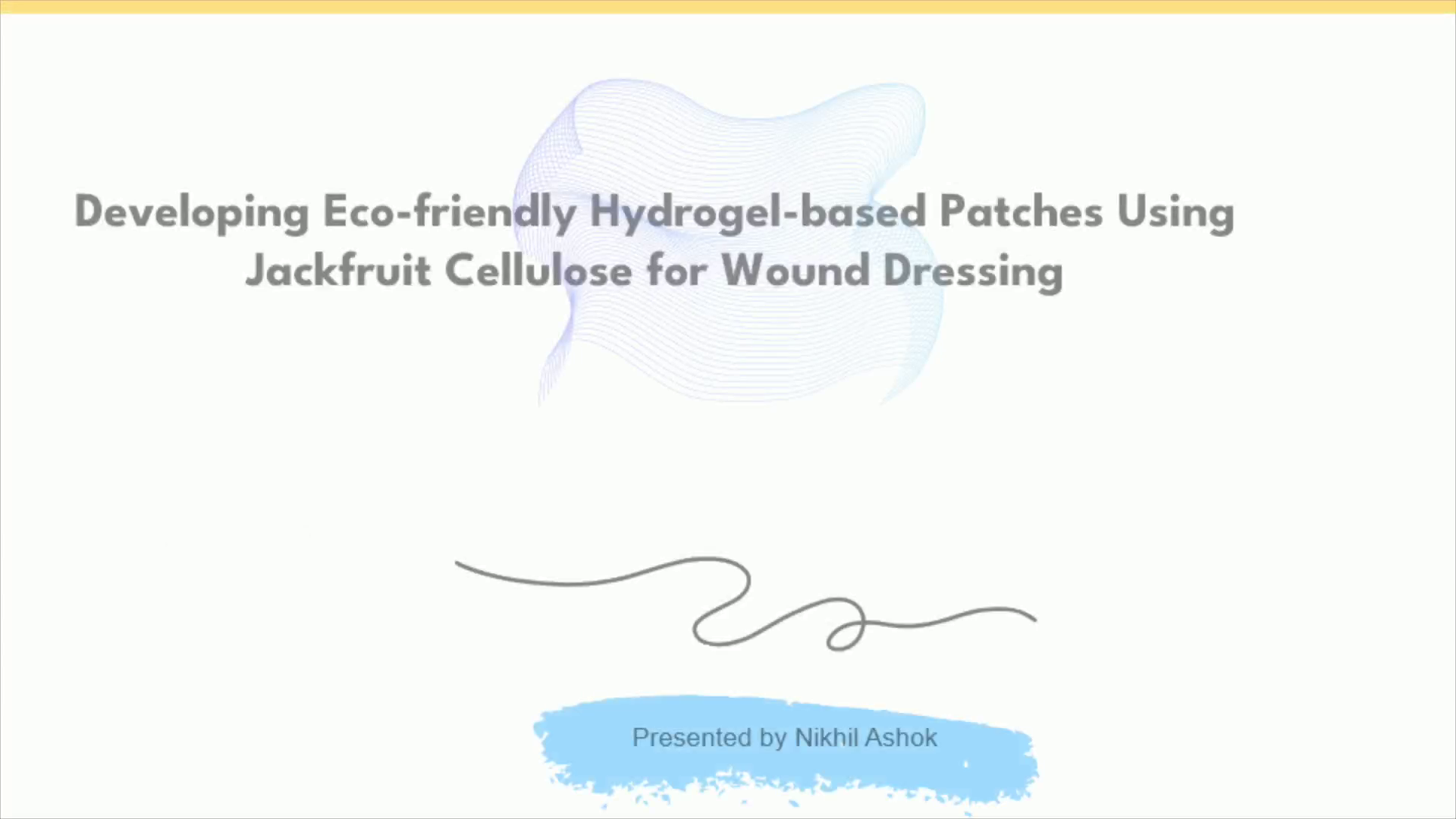
Developing Eco-friendly Hydrogel-based Patches Using Jackfruit Cellulose for Wound Dressing
Scene 1 (0s)
[Audio] Hello every one, I'm Nikhil Ashok, a Biomedical Engineer with a background in both bachelor's and master's degrees, the latter obtained in Germany with a thesis focus on Biosensors. Presently, I'm employed as a Biomedical Engineer at the Cochin Cancer Research Centre. The name for my product as "Green skin". An Eco-friendly Hydrogel-based Patches Using Jackfruit Cellulose for Wound Dressing. The Main Goal is to Address Wound Dressing Needs with Sustainable and Biocompatible Solution.
Scene 2 (35s)
[Audio] During the COVID-19 lockdown, I observed a surge in cooking activities, prompting me to explore cooking myself. Coincidentally, I had an abundance of jackfruit trees on my property, and with everyone staying home, there was no sharing of homegrown crops. This led me to notice a significant wastage of jackfruit, particularly the husk. Intrigued, I did some research and stumbled upon an article discussing the extraction of cellulose from jackfruit husks and later with the help of literatures I found that these cellulose can be transformed into hydrogel patches for wound dressing. Jackfruit husks are typically considered waste and constitute a significant portion of the fruit's weight. Proper disposal of this waste can be costly and poses environmental challenges. Food processing companies primarily discard the husk, using only the flesh and seeds. My plan involves collecting this husk and extracting cellulose for further processing. You might wonder why I chose jackfruit over other options. My goal is to convert this seemingly discarded jackfruit husk waste into a value-added product, such as Patches. Furthermore, there's existing research suggesting that jackfruit powder can help lower diabetic levels, which could enhance the appeal of my hydrogel patch..
Scene 3 (2m 1s)
[Audio] Currently, natural-based Patches or band-aids are not prevalent in the market, with most products being PVC-based. Hydrogel patches used to reduce the excessive scar tissue formation after surgery and they are typically made from synthetic materials and antimicrobial property is introduced using metallic compounds such as silver or copper ions. My proposal involves utilizing jackfruit cellulose to create hydrogel-based Patches or band-aids which are synthesized from natural material. Additionally, I aim to enhance their antibacterial properties and mechanical stability. These cellulose-based hydrogels naturally decompose within 1-2 months, offering advantages such as non-toxicity, biocompatibility, biodegradability, and sustainability compared to synthetic counterparts, which are costlier..
Scene 4 (2m 54s)
[Audio] In summary, my idea is to develop eco-friendly hydrogel-based Patches using jackfruit cellulose, addressing wound dressing needs with benefits like high exudate capacity, pain reduction, and ease of handling. While natural-based Patches are rare in the market, my product seeks to bridge this gap while being environmentally friendly. Lastly, I'm exploring the incorporation of anti-microbial, antiviral, and anti-inflammatory properties using extracts from the commonly available ornamental plant, Hemigraphis Colorata (also known as Vrana Roopini in Sanskrit)..
Scene 5 (3m 31s)
[Audio] The proposal is to use extracts from - Hemigraphis Colorata for adding antimicrobial properties to the patch Hemigraphis colorata is a medicinal plant native to the tropical regions of Kerala, It is a perennial herb that is commonly grown as an ornamental plant and is known by various names such as "murikooti" or "muryanpacha". This plant has several valuable properties and is used in traditional medicine for its medicinal benefits. Some of the medicinal properties associated with Hemigraphis colorata include: 1. Anti-microbial activity: It has been used as an herbal ointment to treat cut wounds, ulcers, and bleeding. 2. Anti-diabetic activity: 3. Anti-oxidant activity: It acts as an antioxidant and exhibits free radical scavenging activity These properties make Hemigraphis colorata a valuable plant in traditional medicine..
Scene 6 (4m 37s)
[Audio] The various steps in Jackfruit-Based Hydrogel Patches Cellulose Extraction from Jackfruit husk 2. Hydrogel Formation using the extracted cellulose 3. Solvent Exchange by which anti microbial property is inserted. 4. Testing and validation of the hydrogel patches.
Scene 7 (5m 5s)
[Audio] The global hydrogel dressing market size was valued at USD 849.23 million in 2021 and is projected to witness a compound annual growth rate (CAGR) of 4.28% from 2022 to 2030. The demand for hydrogel dressing is projected to increase due to the rising chronic and acute wound population The market study indicates that hydrogel dressing aids in the treatment of chronic wounds, including pressure ulcers, venous leg ulcers, and diabetic foot ulcers. The global hydrogel dressing market is expected to grow due to increased occurrences of burns and trauma..
Scene 8 (5m 44s)
[Audio] Developing a prototype may take one year with 2-4 group members. If I am able to obtain funding, I am planning to register with Bionest in Kalamassery. Expecting 6 months for fabrication of hydrogel and another 6 months to validate the hydrogel. Various challenges to be addressed are The product should be cost-effective. Confirmatory tests in each step. Clinical trials (for class 1 prescribed by CTRI/ Government of India). The scaling up of production and establishing a market. During the experimental stage the production cost is expected to be Rs.400-600 per unit. Initially the production would be of 100,000 units and assessing the market approval we are expecting to increase the production..
Scene 9 (6m 41s)
[Audio] Future plans developing Other Biomedical Applications like Drug Delivery system using the hydrogel and incorporating Biosensors to monitor wound healing. I thank you all for your time..